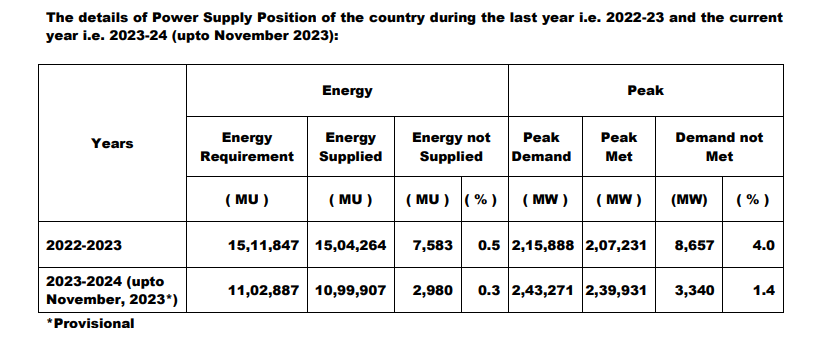Highlights :
- Union Minister RK Singh data said that India’s generation capacity increased from 248554 MW in March 2014 to 425536 MW in October 2023.
- The minister said that the electricity demand rose from 1,35,918 MW in 2013–14 to 2,43,271 MW in September 2023.
 SunSource Commissions 75 MW Open Access Solar project iIn Karnataka.
SunSource Commissions 75 MW Open Access Solar project iIn Karnataka. Union Power Minister RK Singh claimed that the electricity demand in India rose almost 79 percent in the last nine years. He shared the latest data before the Lok Sabha in his written response to a question. He said the electricity demand rose from 1,35,918 MW in 2013–14 to 2,43,271 MW in September 2023. He also said that with the rise in installed capacity in India, the gap between peak electricity demand and peak electricity demand met also shrank.
“The peak demand has gone up from 135918 MW in 2013-14 to 243271 MW in September 2023. This is a rise of almost 79% in last nine (09) years. This increase in demand is because of two factors :- (1) India has been one of the world’s fastest growing major economies in recent years and (2) 2.86 Crores households have been provided new electricity connections. To meet the demand, we have added 193794 MW generation capacity in the past nine (09) years transforming our country to power sufficiency,” he told the Lok Sabha.
He also added that there was a 70 percent slump in generation capacity, from 2,48,554 MW in March 2014 to 4,25,536 MW in October 2023. Thus, the gap between peak electricity demand and peak electricity demand met has decreased from 4.5% in 2013–14 to 1.4% in 2023–24 (up to November 23). The installed capacity overall witnessed an increase in the installed capacity of the renewable sector from 75,519 MW in March 2014 to 1,78,983 MW in October 2023.
The data further showed that 1,87,849 circuit kilometers (ckm) of transmission lines, 6,82,767 MVA of transformation capacity, and 80,590 MW of inter-regional capacity had been added. This line connects the whole country into one grid running on one frequency, with the capability of transferring 1,16,540 MW from one corner of the country to another.
The minister mentions that the government has constructed ‘Green Energy Corridors’ and put 13 renewable energy management centers in place. Presently, renewable energy capacity is at 1,78,000 MW, and 99,000 MW is under installation.
He added that the Aggregate Transmission and Commercial (AT&C) losses have decreased from 22.62% in 2013–14 to 15.41% in 2022–23. The minister, who also holds the charge of the Ministry of New and Renewable Energy, said that all current payments from Gencos are also up-to-date. He further mentioned that Gencos’ legacy dues have come down from Rs. 1.35 lakh crore to Rs. 6,000 crore. The subsidy payments to discoms on account of subsidies announced by the state government are also up-to-date.
The government’s three schemes, namely various Deen Dayal Upadhyaya Gram Jyoti Yojana (DDUGJY), Integrated Power Development (IPDS), and Pradhan Mantri Sahaj Bijli Har Ghar Yojana (SAUBHAGYA) schemes, electrified 18374 villages. Additionally, 2.86 crore households were provided electricity connections. As a result, 100% of the villages have been electrified, he told the Lok Sabha.
Besides this, 2927 new substations have been added, an upgrade of 3965 existing substations has been carried out, and 8.86 lac circuit km of HT and LT lines have been added or changed. As a result of these measures, the availability of power in rural areas has increased from 12 hours in 2015 to 20.6 hours in 2023.
The total power generation capacity in the country as of March 31, 2013, was around 223 GW.

Power Supply Position of India between 2022- 2023 (Till November)



























